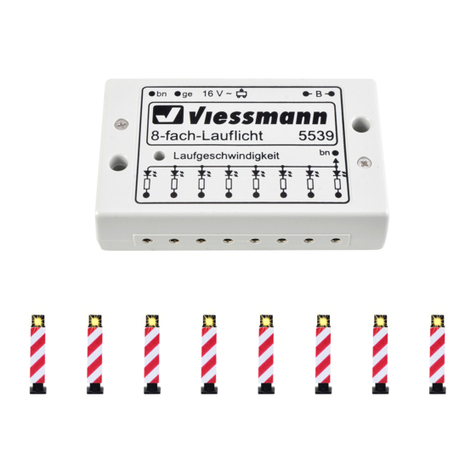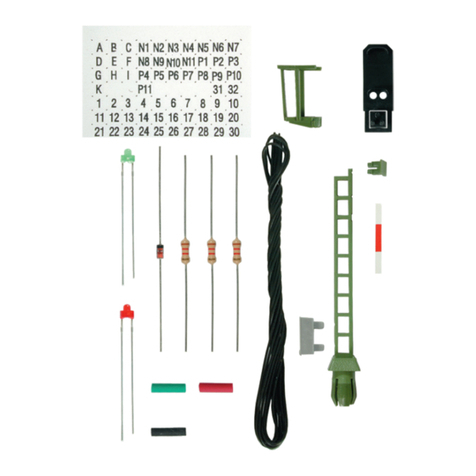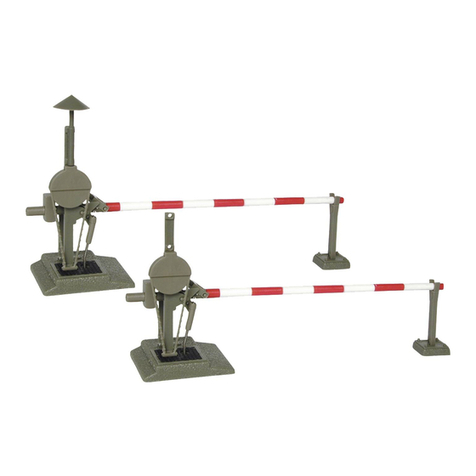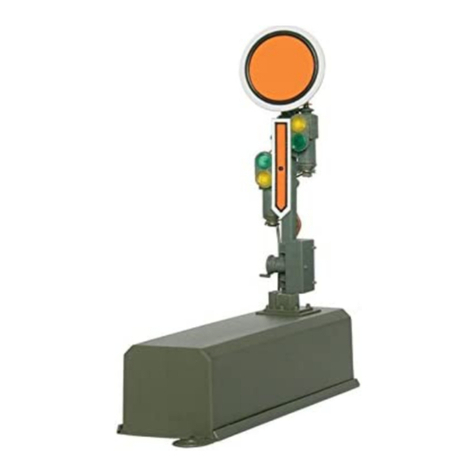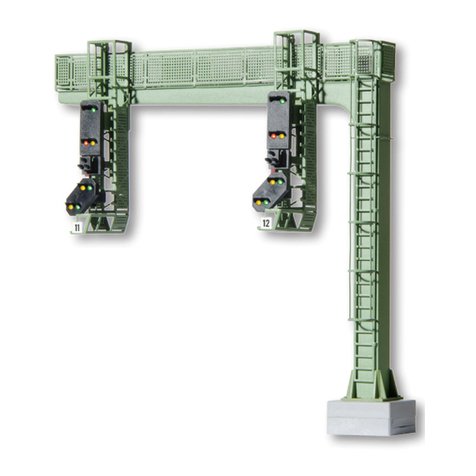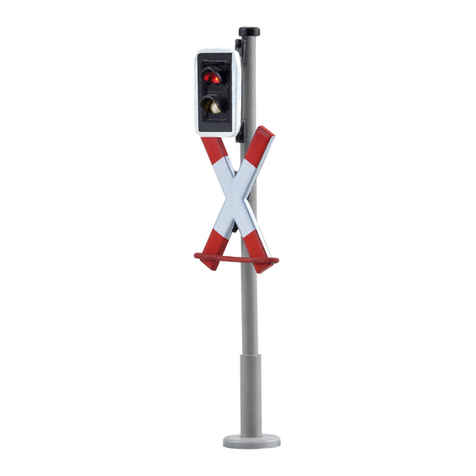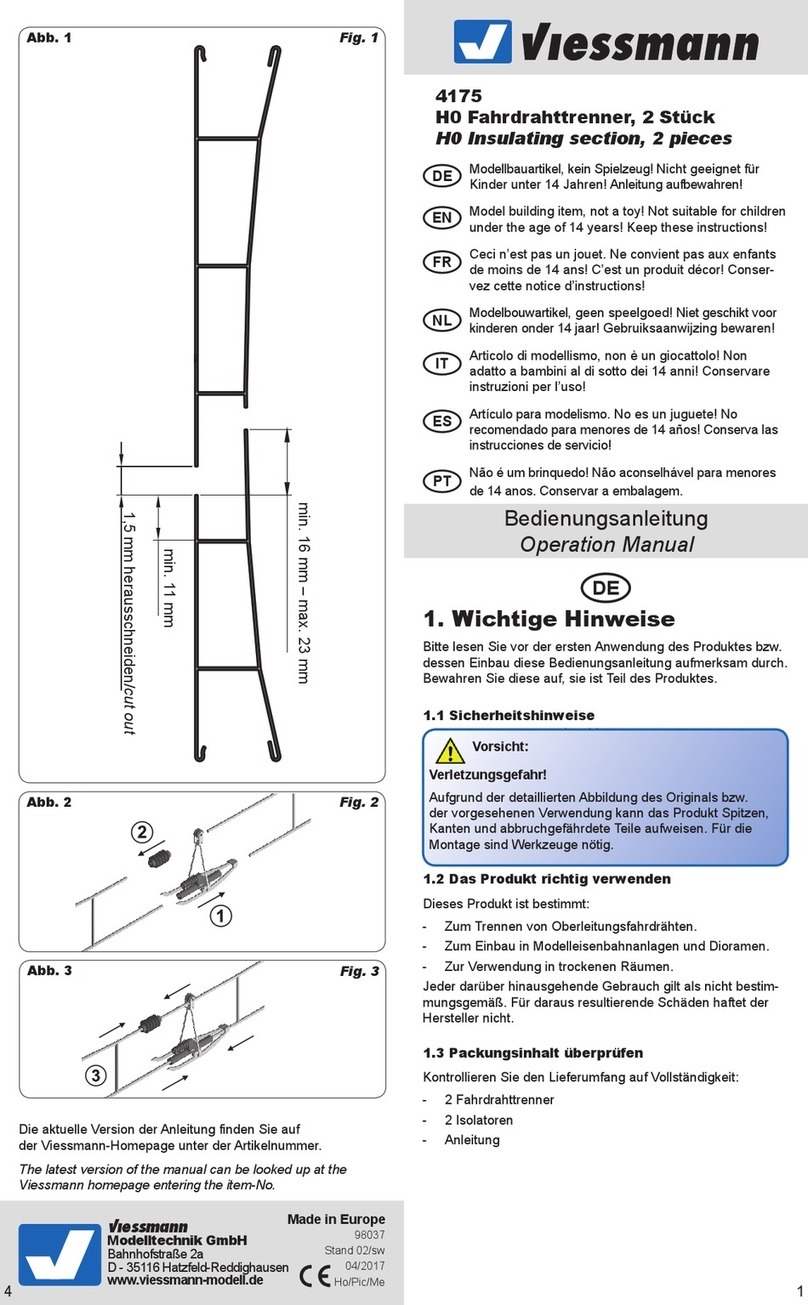
10
Die weiteren Einstellmöglichkeiten entnehmen Sie der
CV-Tabelle. In CV 40 können Sie auch das Protokoll fest-
legen, auf das der Türantrieb später „hört“.
Auf Befehle am Programmierausgang einer DCC-kompa-
tiblen Zentrale hört der Decoder immer - unabhängig vom
eingestellten Protokoll.
4.6 Einrichtung mit Motorola-Zentralen
Damit Sie den Türantrieb digital ansteuern können, müssen
Sie diesem zunächst eine Digitaladresse zuweisen. Zur Steu-
erung im Märklin-Motorola-System gehen Sie wie folgt vor:
1. Schalten Sie das Digitalsystem aus, z. B. Not-Aus.
Es darf keine Spannung mehr am Gleis anliegen.
2. Verbinden Sie nur die grün markierte Steuerleitung
und die Stromversorgungsleitungen des Türantriebs
(braun und gelb, Abb. 5) mit dem Gleis.
3. Schalten Sie das Digitalsystem ein.
4. Verbinden Sie die rot markierte Steuerleitung gleich-
falls mit dem Gleis (Abb. 6).
5. Senden Sie mit der Digitalzentrale nun für die ge-
wünschte Motorola-Adresse einen Schaltbefehl.
Der Türantrieb empfängt den Befehl, registriert die
Damit ist der Türantrieb unter der neuen Adresse be-
triebsbereit. Falls Sie die Adresse künftig ändern möch-
ten, wiederholen Sie die Prozedur einfach.
Beachten Sie: Wenn Sie eine Zentrale einsetzen, die
sowohl das DCC- als auch das Motorola-Format sendet,
ist die Programmierung des Türantriebs im DCC-Format
empfehlenswert. Im Motorola-Format ist der Adressbe-
reich bei vielen Zentralen auf 320 Adressen beschränkt.
4.7 Digitalbetrieb auf einer Lokadresse
gehen Sie wie folgt vor:
Bestimmen Sie, welches Digitalsystem verwendet wer-
den soll. Gehen Sie dazu vor, wie unter den Punkten 1
bis 4 bei „Einrichtung mit DCC-Zentralen“ oder „Einrich-
tung mit Motorola-Zentralen“ beschrieben. Stellen Sie alle
Lokomotiven auf Fahrstufe Null, sofern Ihre Zentrale dies
nicht automatisch tut.
An Punkt 5 senden Sie jedoch keinen Weichenschalt-
befehl, sondern einen Lok-Fahrbefehl auf der Adresse,
die der Antrieb bekommen soll. Betätigen Sie dazu den
Fahrregler, so dass eine Fahrstufe an die Adresse ge-
sendet wird, die nicht Null ist. Diese Adresse entspricht
der Gruppenadresse eines typischen 4-fach-Decoders.
Auf dieser Lokadresse wählen Sie dann eine Funktion F1
bis F4, die dadurch dem Türantrieb zugeordnet wird. So-
mit können Sie 4 Türantriebe auf eine Lokadresse legen,
analog zum 4-fach-Decoder. Der Adressbereich ist auf 1
4.8 Programmieren mittels POM
Der Decoder lässt die Programmierung aller CVs per POM
(„Programming on the Main“, „Hauptgleisprogrammierung“) zu.
Nicht alle Zentralen unterstützen POM-Befehle an Schaltar-
tikel-Decodern, deswegen kann man den Decoder auch auf
Lokdecoder-POM Modus umstellen. Dies geschieht dadurch,
-
ben wird. Der Antriebsdecoder hört dann auf normale POM-
Befehle für Lokomotiven unter seiner aktuellen Adresse.
Further programming options are listed in the CV table.
You may also set the desired digital protocol in CV 40.
The decoder will respond to commands of the program-
ming output of a DCC compatible command station
regardless of the set protocol.
4.6 Conguration with Motorola central units
To use the motor door in a digital environment, you have to
assign a digital address rst. To control the motor door with
a Motorola system, observe the following instructions:
1. Switch o the digital system (e. g. emergency o).
There must not be any power at the rail.
2. Connect only the blue wire with the green marking
and the power supply wires of the motor door (brown
and yellow, g. 5) to the rail.
3. Switch on the digital system.
4. Connect the second blue wire (red marked) to the
track, too (g. 6).
5. Use the digital command station to send a point
request for the desired Motorola address. The door
drive receives the request, registers the address as its
own and as a receipt, it does the switching.
The door drive is now ready to be used with the new digi-
tal address. If you want to change the address, you just
have to repeat the described procedure.
Notice: If you use a multi protocol digital command
station, which is able to use the Motorola- as well as
the DCC-system simultaneously, it is recommended to
program the door drive on a DCC-address. When using
Motorola format only 320 addresses may be provided.
4.7 Digital mode with a locomotive address
Proceed as follows if you wish to program the decoder to
a locomotive address:
Decide which digital system you are going to use. Pro-
ceed as described in points 1 - 4 in the chapter “Congu-
ration with DCC command stations” or “Conguration with
Motorola central units”. Set all locomotives to speed step
0 if your command station does not do that automatically.
Instead of the switching command as per point 5 send
a locomotive driving command to the address to be as-
signed to this drive. Turn up the throttle in order to send
a speed command greater than 0. This address corres-
ponds to the typical group address of an accessory
decoder with four double-outputs. Select one of the func-
tions F1 - F4 of this locomotive address, which assigns
the functions of this address to the door drive. Thus you
may control four drives with one locomotive address
similar to a fourfold decoder. The address range is limited
to addresses from 1 - 99.
4.8 Programming with POM
The decoder supports programming of all CVs per POM
(“Programming on the main”). Since not all command sta-
tions support POM for switching decoders you may also
set the decoder to respond to the locomotive POM mode.
Enter the value 80 in CV 8 of the address 9999. Then the
drive decoder responds to normal POM commands for
locomotives under the respective address.
